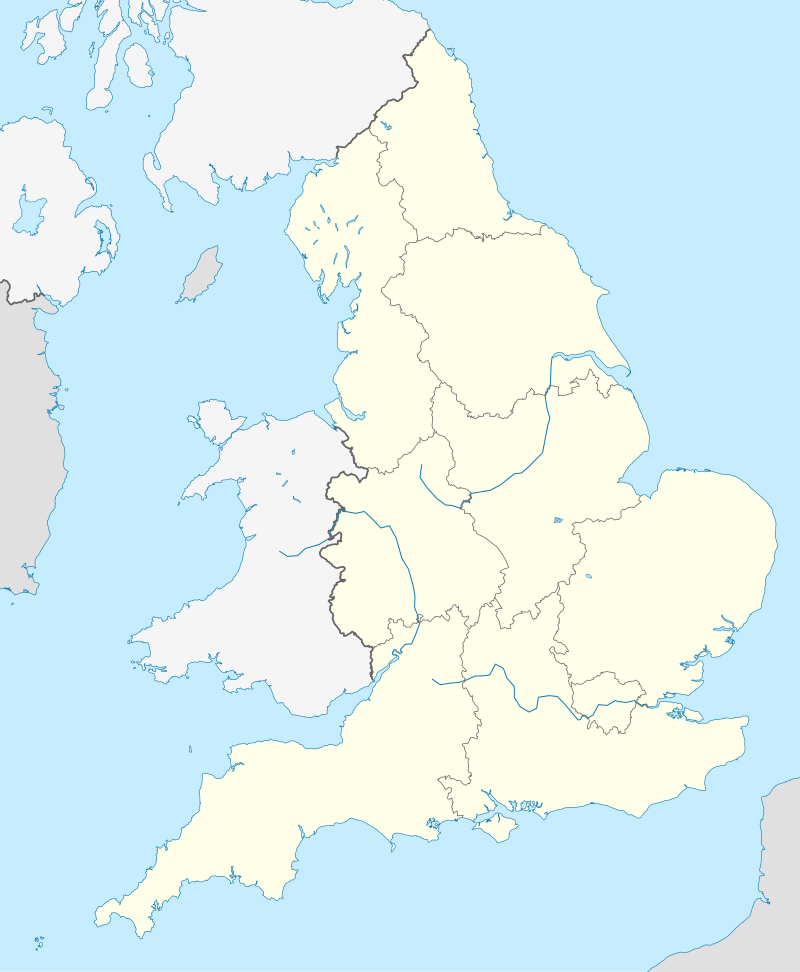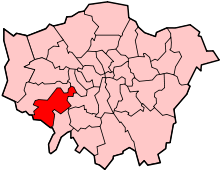St Mary's Church, Twickenham
St Mary's Church, Twickenham, also known as St Mary the Virgin, Twickenham, is a Grade II* listed Church of England place of worship dedicated to Saint Mary the Virgin in Church Street, Twickenham, Middlesex, England.[2]
| St Mary's Church, Twickenham | |
|---|---|
 St Mary's Church, Twickenham (in 2006) | |
 St Mary's Church, Twickenham | |
| 51.447°N 0.3255°W | |
| Location | Church Street, Twickenham, Middlesex, England |
| Country | United Kingdom |
| Denomination | Church of England |
| Previous denomination | Roman Catholic |
| Website | stmarytwick |
| History | |
| Dedication | St Mary the Virgin |
| Consecrated | 1714 |
| Associated people | Godfrey Kneller[1] |
| Architecture | |
| Architect(s) | John James[1] |
| Architectural type | Neo-classical |
| Specifications | |
| Materials | brick, stone |
| Administration | |
| Parish | St Mary's, Twickenham |
| Deanery | Hampton |
| Archdeaconry | Middlesex |
| Diocese | London (Kensington Area) |
| Province | Canterbury |
| Clergy | |
| Vicar(s) | Revd Jeff Hopkin Williams |
| Assistant priest(s) | Revd Dr Piotr Ashwin-Siejkowski |
| Laity | |
| Director of music | Adrian Mumford |
| Churchwarden(s) | Judy Britton Katherine Cox |
Listed Building – Grade II* | |
| Designated | 2 September 1952 |
| Reference no. | 1080852 |
The parish church stands a short distance from York House and the banks of the River Thames, immediately opposite Eel Pie Island.
History
The church stands on the site of an earlier one and incorporates its 15th-century medieval tower. On 9 April 1713 the ancient church's 14th-century nave collapsed. The painter Godfrey Kneller was a churchwarden of St Mary's at the time and was active in the plans for reconstruction in the Neo-classical style by the local architect John James.[1][3] A local resident, Lady Wentworth, wrote a month after the collapse that it had been foreseen by a new vicar, Dr Pratt:[3]
Dr Pratt had insisted that a tabernakle be erected in the churchyard, prior to the collapse. Soe he preached there and exhorted al to giv thanks for thear great deleverenc for the church not falling when they wear in it, it being then standing. The people all laughed at him, and in a weeks time it fell to the ground, soe all the parish contrebutse to the building of it.[3]
Inside the 18th-century church some older monuments have survived from the medieval nave, including a brass to Richard Burton, the King's chief cook, and Agnes his wife, dated 1443.[3][4]
On 20 June 1721 Dr Pratt baptised at the church "James Shandayes and John Twogood", described as two Indian princes.[5] They were followed in 1747 by Henry Fielding's son William.[6] Hallam Tennyson, son of the poet Alfred, Lord Tennyson, and eventually second Governor-General of Australia, was christened at the church in 1852.[7]
The 18th-century nave of the church is in red brick with Tuscan pilasters and pediments. Following the reconstruction of 1713–14, the church was enlarged in 1754 and contains fittings of the same period, including a reredos and gallery fronts. The tower has a ring of eight bells, of which one dates from the early 16th century, three from the 17th and four from the 18th.[4]
Extent of parish
Like the ancient church on the site, the present one began life as the parish church for the whole of Twickenham. However, housing development in the 19th and 20th centuries led to new parishes being created for several new Church of England churches: Holy Trinity, Twickenham Common (1842), St Philip and St James Church, Whitton (1862), St Stephen's, East Twickenham (1875), All Saints, Twickenham (1914) and All Hallows, Twickenham (1939). As these came into being, the parish of St Mary's became smaller, but it still takes in most of central Twickenham.[4]
Burials
- Bridget Markham and Cecily Bulstrode, ladies in waiting to Anne of Denmark who both died at Twickenham Park in 1609. Markham is commemorated with an inscription inside.[8]
- Sir William Berkeley (1605–1677), Governor of Virginia from 1660 to 1677, was laid to rest in the crypt of the church in 1677, unusually encased in "lead exactly fitted to the shape of the body, shewing the form of the features, hands, feet, and even nails", instead of a coffin.[9] A year later he was joined by the remains of his brother Lord Berkeley, one of the Lords Proprietor of New Jersey. The brothers are commemorated in a memorial window in the present church, under which the ancient crypt survives.[9]
- Sir Godfrey Kneller died in 1723 and his remains were entombed in the church.[1]
- Alexander Pope (1688–1744) lies in the church under a stone slab engraved simply with the letter P, near a bronze memorial plate,[10] joining his mother, Edith Pope (1643–1733), who had been buried in the church in 1733.[4]
- The well-known actress and soprano singer Kitty Clive (1711–1785) was buried in the churchyard in 1785. A plaque to her memory was affixed to the outside wall in the north-east angle of the church chancel.[10]
- General William Tryon (1729–1788), a soldier who served as governor of the Province of North Carolina (1765–1771) and of the Province of New York (1771–1780) was buried in the churchyard in 1788.[11]
- At the north-east corner of the church, in the graveyard, are memorials to the tea merchant Thomas Twining (1675–1741) and the actress Kitty Clive (1710–1785).[10] Martha Bruce, Countess of Elgin and Kincardine, former governess of Princess Charlotte of Wales, was buried at St Mary's on 4 July 1810.[12]
- There is a memorial to timber merchant James Montgomrey’s wife Henrietta (1818–1905) in the church, but both she and her husband were buried at Isleworth Cemetery[13][14]
- The funeral of Neil Aspinall (1941–2008), head of The Beatles' company Apple Corps and sometimes called "the fifth Beatle", took place at the church in 2008, although Aspinall was buried at Teddington.[15]
See also
- All Hallows Twickenham
- Pope's Urn
References
- Richard Stuteley Cobbett, Memorials of Twickenham: parochial and topographical (Smith, Elder & Co., 1872), p. 402
- London Borough of Richmond upon Thames: Listed buildings (pdf file) at richmond.gov.uk
- St Mary's Church at twickenham-museum.org.uk, accessed 14 October 2012
- SAINT MARY THE VIRGIN, TWICKENHAM at aim25.ac.uk, accessed 20 October 2012
- Frederic Chapman, illus. Thomas R. Way, Architectural Remains of Richmond, Twickenham, Kew, Mortlake, and Petersham (The Wildhern Press, 2008 edition, ISBN 184830059X), p. 65
- Martin C. Battestin, A Henry Fielding Companion (Greenwood, 2000, ISBN 031329707X), p. 4
- Cecil Y. Lang & Edgar F. Shannon, Jr. (eds.), The Letters of Alfred Lord Tennyson, Volume II: 1851-1870 (Belknap Press of Harvard University Press, 1987, ISBN 978-0674525849), p. 47
- Richard Stutely Cobbett, Memorials of Twickenham (London, 1872), p. 86.
- Warren M. Billings, Sir William Berkeley and the Forging of Colonial Virginia (Louisiana State University Press, 2010 edition), p. 268 (footnote)
- Lynn F. Pearson, Discovering Famous Graves (Shire Discovering vol. 288, 2008, ISBN 0747806195), p. 82
- Paul David Nelson, William Tryon and the Course of Empire: A Life in British Imperial Service (University of North Carolina Press, 1990, ISBN 0807819174), p. 181
- George Cokayne, The Complete Peerage, vol. E to G (St Catherine Press, Limited, 1926), p. 43
- B. F. Ronalds, “The Montgomrey Family of Brentford: Timber Merchants and Benefactors” in London’s Industrial Archaeology, volume 16, pp. 57-69
- A. B. Willson, Memorials and Ledgerstones of St Mary’s Church Twickenham
- Anita Singh (9 April 2008). "Yoko Ono and Stella McCartney attend 'fifth Beatle' Neil Aspinall's funeral". Daily Telegraph. London. Retrieved 13 January 2013.
Further reading
- The story of St Mary's, the parish church of Twickenham (Parish Church of St Mary's Twickenham, 1961)
- The Parish Church of Twickenham, St Mary the Virgin (British Publishing Company Limited, 1975, ISBN 0714010472)
- E. A. Morris, The Bells of St Mary's, Twickenham (State Mutual Book & Periodical Service, 1986, ISBN 0785520104)
- Adrian Mumford & Donald Herbert Simpson, The Organs of St Mary's Parish Church, Twickenham (St Mary's Parish Church, 1996, ISBN 0952831503)
External links
- Official website
- St Mary's, Twickenham, graves at gravestonephotos.com
- St Mary the Virgin, Twickenham, Middlesex at flickr
